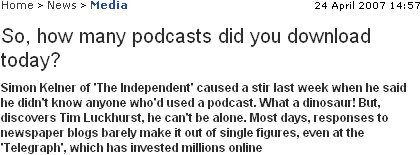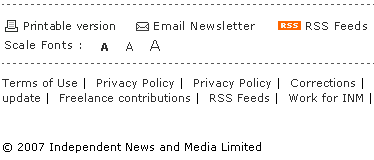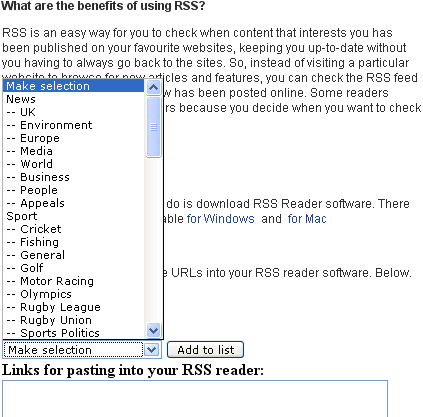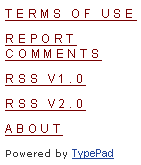Newspapers 2.0: How Web 2.0 is The Independent?
Over the last week-and-a-bit I've been studying how British newspapers have adopted so-called Web 2.0 technologies and services on their websites - things like RSS feeds, blogs, user generated comments, and social bookmarking widgets.
So far I've looked at The Express, The Times, The Mirror, The Telegraph and the Daily Mail.
Today I want to look at The Independent, a paper that has recently been much criticised for their lack of investment in their web site and adopting a cautious "wait and see" policy, whilst publishing articles that suggest their rival publishers are wasting their money on investing in the future of their websites.

RSS Feeds
The Independent has a small RSS logo embedded in the footer of their page, alongside links to change the font-size or switch to a print version of the page, and a link to their email newsletter service.
The RSS feeds link is also repeated at the very bottom of the page, in amongst the copyright and 'legal' links.

This same set of links appears in the footer of all individual story pages, and they are not context sensitive. They always link through to a generic RSS help page, rather than to the appropriate feed for that article.
The RSS help page lists The Independent's feeds, and provides a slightly odd way of subscribing to them. Instead of providing a visible list of feeds, the titles of the feeds are included in a drop-down menu. Clicking the title adds the URL for the XML feed into a text-area below the drop-down, which can then be copied and pasted into the appropriate subscription mechanism.

The range of feeds offered by the newspaper - 69 - is impressive, but they only contain snippets of articles, and there are some bafflingly odd feeds in there.
For example, the written output of The Independent's columnists is divided into two separate RSS streams - Columnists A-L and Columnists M-Z.

I can't imagine any user in any focus group ever suggesting that their newspaper comment consumption depended on the initial letter of the surname of the columnist - "I love my Littlejohn, but can't stand that Rees-Mogg fella. I mean, both his surnames are in the M-Z range".
The set-up is slightly different for The Independent's blog pages

Here, two flavours of RSS are offered in the left-hand navigation of the page, and appear to use the default Typepad set-up, which means that unlike elsewhere on the site, a full feed is offered. Not, as we shall see, that it is of much worth, due to the astonishing lack of content on the blogs themselves.
User Comments and Social Bookmarking
The Independent does not currently appear to have any social bookmarking links or widgets on either their main site or their blog pages. Likewise, aside from the comments on their barely updated blogs, user generated content on the site appears restricted to the online republication of the letters that have made it into the newspaper's print edition.
Blogs
The Independent's implementation of blogging looks to be the poorest and most half-hearted attempt at riding the blogging train of any major newspaper in the UK.
So far I have criticised both The Express and The Mirror for the lack of compelling content, user comments or frequent posting on their blogging efforts. The Indepedent, however, in this regard is streets ahead (or should that be behind?) them.

Navigation to the blogs offered by The Independent is tucked away under the services section of the newspaper's right-hand navigation area.

The Independent's blog "section" appears to have only three blogs on offer, Comedy, Photography and the Environment. Like several other papers, The Independent has chosen Typepad as their blogging platform, indicated not just by the credit in the left-hand navigation, but also by the URL - http://indyblogs.typepad.com/independent/ - and the distinctive Six Apart favicon.
The Independent though, has chosen not to configure three distinct blogs, but instead the mutually exclusive topics are set up as three categories on one blog.
The content is the most stale of the newspaper blogs I have written about. At the time of review, so far in 2007, on the three topics, there has been the grand total of two posts. The first of these (on March 22nd) starts with an apology for not updating frequently. The author's next post is a mere 15 days later.

On the 24th of April, when I last reviewed the site, the cameras topic hadn't been updated in the four months since December 16th 2006
The last entry on the Environment blog was on November 3rd last year, chiefly consisting of links through to 5 recent Indy stories about global warming.

On the assumption that to have more than one author on their blog they have picked the Pro Typepad pricing option, it looks like The Indpependent's total investment in blogging is something like £8 per month.
And it shows.
Web 2.0 Verdict
The Independent is without a doubt the least "Web 2.0" of any of the British newspaper websites that I have looked at. Their RSS feed coverage is thorough, if a little oddly categorised at times, and with a non-standard method of allowing users to subscribe. However The Independent has not touched upon the social bookmarking phenomena, nor moved to incorporate any kind of user comments alongside their stories and editorial content.
The Independent's blogs are frankly an embarrasment to the brand. With only 8 entries posted across the 3 blog categories in the last 6 months, strategically the paper should surely just kill the idea of doing blogging at all, and instead leave it to papers like The Telegraph, The Guardian and The Times, which seem to making a good go of the blogging format. The paper certainly doesn't seem to be any position to offer criticism of any other newspaper site on web.
Next...
In the next part of this series I want to look at a paper that is often bracketed with The Independent as a left-leaning ex-broadsheet, but which appears to be making a much greater impact on the web - The Guardian.
Indeed, their online offering is rubbish. Which is frustrating, as it's the physical newspaper I read most often. Until recently they even had a confusing pay-for-access offering for archive articles, which I could never quite get my head around. And they've got a policy which tries to prevent deep-linking: http://news.independent.co.uk/article294419.ece
If they fancy hiring me, I could soon sort it out...
One thing I DO like about their website, though, is the way they display a scan of their current [physical] front page. It wouldn't be relevant on many other newspaper websites, but for the Independent, which often has great, creative front pages, it's a good idea. Thinking about it, if they kept an archive of these, it could even be a feature around which some online social interaction took place - their front pages do, after all, provoke comment, reaction. They could even let users pick their 'favorite' front pages...
My newspaper purchasing habits when I still lived in London was to rotate around The Guardian, Independent and The Times, and then hope to pick up a tabloid for free off the tube. Of course, at the office we had copies of all papers as well. I enjoyed The Independent in print, it really is a shame that their website just doesn't seem to do the journalism justice.